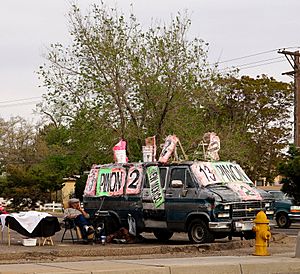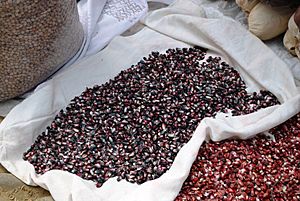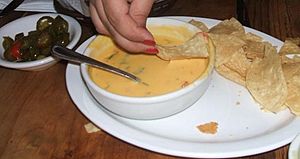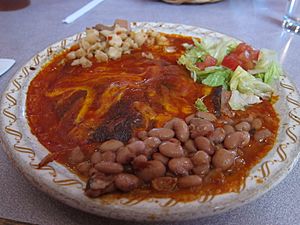New Mexican cuisine facts for kids
New Mexican cuisine is the special food style of New Mexico in the United States. It's famous for mixing the cooking traditions of the Pueblo Native Americans with Spanish and Mexican foods from long ago.
This unique food style has changed over time. It got ideas from the nearby Apache and Navajo tribes, and from the larger Spanish Empire. Later, it was influenced by French, Italian, and other European foods. When New Mexico became part of the U.S., cowboy chuckwagons and diners on Route 66 also added new flavors.
Even with these changes, New Mexican cuisine stayed special. It kept its Native American, Spanish, and Mexican roots strong. This means it's different from other Latin American foods you might find in the U.S.
You can easily tell New Mexican food apart because it uses special spices and herbs. The most important are red and green New Mexico chile peppers. Other key flavors include anise (in cookies called bizcochitos) and piñon nuts (for snacks or desserts).
Many dishes started right here in New Mexico. These include sopapillas (a type of fried bread), breakfast burritos, stacked enchiladas, green chile stew, carne adovada (pork in red chile), and posolé (a corn dish). You'll also find slow-cooked frijoles (beans) and calabacitas (a squash dish).
Contents
The History of New Mexican Food
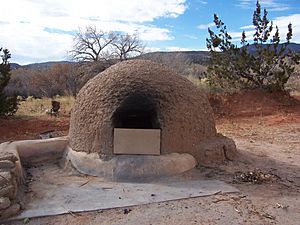
Long ago, the land of New Mexico was home to the Pueblo people. It also included lands of the Chiricahua, Comanche, Mescalero, and Navajo tribes.
When the Spanish arrived, they brought their own foods. These mixed with the native ingredients. The Spanish introduced wheat, rice, beef, and lamb. These joined the native corn, chile, beans, and squash.
During this early time, the horno became very common. This is an outdoor, beehive-shaped oven made of earth. You can still see them in Pueblo and Hispano communities. This unique history, along with the local land and weather, made New Mexican food very different from similar styles in Northern Mexico or other Southwestern states like California, Arizona, and Texas.
New Mexico has a long history of farming. Native Americans have worked the land for thousands of years. Spanish farmers and ranchers arrived in the 1500s. Later, Americans came after the Civil War. Today, people from all over the world live in New Mexico, adding to its food traditions.
When New Mexicans say chile, they mean the spicy pepper pods or a sauce made from them. They are not talking about the meat and bean dish called Texas chili con carne. The official spelling for the pepper in New Mexico is chile.
One of the first people to write a cookbook about New Mexican food was Fabiola Cabeza de Baca Gilbert. She published Historic Cookery in 1931. Her book helped introduce cooking with chiles to more people across the United States.
Key Ingredients in New Mexican Cuisine
What is New Mexico Chile?
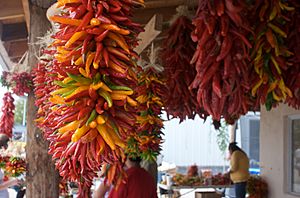
New Mexico chile is the most important ingredient in New Mexican food. It's the biggest farm crop in the state. Green chile is so popular that it's even used in non-New Mexican foods like cheeseburgers, french fries, and pizza.
New Mexico has an official State Question: "Red or green?" This asks if you want red or green chile with your meal. "Christmas" means you want both! New Mexico red and green chile have such a rich flavor that they don't need many other ingredients. Simple is best!
The New Mexico green chile is a type of Capsicum annuum pepper. It was developed in New Mexico in the late 1800s. Today, there are many different types, called cultivars.
These peppers grow in New Mexico's high altitude (4,000–8,000 feet) and dry, hot climate. These conditions, like with grapes for wine, give the chile its special deep green color, texture, and flavor. The climate also tends to make the chiles hotter. New Mexico green chiles can be mild or very spicy.
When green chile is harvested (August to October), it's usually roasted, peeled, and frozen for the year ahead. Chile is so important that many national restaurants in New Mexico offer it on their menus.
New Mexico red chile is simply a fully ripened green chile pepper. As it ripens, it turns orange, then red. The skin gets thicker. For red chile to be tasty, it must be dried and then blended into a paste. This paste is cooked into red chile sauce. It's made with garlic, salt, and sometimes oregano, and looks like tomato soup.
Many New Mexicans prefer sun-dried red chile. Oven-drying can give it a smoky taste and darker color. Red chile peppers are traditionally sun-dried in bundles called ristras. These are common decorations on porches and in homes. Making a ristra takes a lot of work, so they are mostly decorative now.
Most New Mexico chile grows in the Hatch Valley in the southern part of the state. It also grows along the Rio Grande River and in Chimayo in the north.
Piñon Nuts: A Sweet Treat
Piñones, or piñon nuts, are a traditional food for Native Americans and Hispanos in New Mexico. They are gathered from the common piñon pine tree. The state of New Mexico protects the name piñon for nuts from certain local pine trees. The nuts are usually harvested after the first winter freeze.
Other Important Ingredients
Wheat flour tortillas are more common than corn tortillas in New Mexico. However, corn tortillas, corn tortilla chips, and masa (corn dough) are used in many traditional dishes. Sometimes, they are made from blue corn. Common dishes include enchiladas, tacos, posole, tamales, and sopapillas served with honey.
Corn is still a main grain. Yellow sweet corn is most common, but white, blue, and red corn are used for special foods like atole and blue-corn tortilla chips. Corn kernels and corn on the cob are often served as side dishes.
Anise is used in some desserts, especially the state cookie, the bizcochito.
Cilantro is a strong-smelling green herb. It's used fresh in salsas and as a topping for almost any dish. It's not common in very old New Mexican cooking, but it's a key flavor in the "Santa Fe style" of food.
Cumin is a spice often linked to "Mexican food." In New Mexico, it's used differently, mostly for ground beef in burritos, tacos, and nachos. It's not used to flavor red or green chile sauces. Oregano is another herb used in traditional New Mexican dishes.
Early Spanish settlers in New Mexico used safflower instead of saffron in their recipes. A special type of safflower from Corrales, New Mexico, called "Corrales Azafran," is still grown and used today.
Popular New Mexican Foods and Dishes
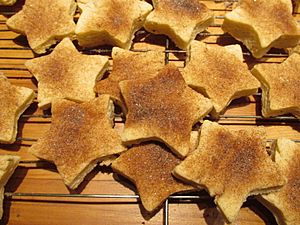
- Albóndigas (meatball soup): Made with beef broth, ground pork or beef, vegetables, and rice.
- Arroz dulce: Sweet rice pudding, a traditional dessert in Northern New Mexico. Rice is cooked in milk and water, then simmered with sugar and raisins. It's served warm with cinnamon.
- Atole: A thick, hot drink or porridge made from blue corn meal.
- Biscochito: An anise-flavored cookie with cinnamon sugar. It's traditionally made with lard. This cookie was created by New Mexicans over centuries. While you can find them anytime, they are a special Christmas cookie.
- Burrito: A white-flour tortilla filled with meat (like pork carnitas, chicken, or carne adovada), refried pinto beans, or both. It's always served with red or green chile.
- Breakfast burrito: A morning version with scrambled eggs, potatoes, red or green chile, cheese (usually Cheddar), and sometimes bacon. This dish started in New Mexico.
- Calabacitas: Chopped summer squash cooked with onions, garlic, yellow corn, and green chile.
- Carne adovada: Cubes of pork marinated and slow-cooked in red chile sauce, garlic, and oregano.
- Carne seca: Means "dried meat." In New Mexico, it's a thin, crispy type of jerky, like a cracker or potato chip.
- Chicharrones: Deep-fried pieces of pork, often with some meat attached.
- Chile con queso: Chile and melted cheese mixed together as a dip.
- Chiles rellenos: Whole green chiles stuffed with cheese, dipped in egg batter, and fried. This dish uses the New Mexican chile, not the poblano pepper.
- Chile sauce: Made from red or green chiles and usually served hot. Green chile sauce uses chopped, roasted fresh or frozen green chiles. Red chile sauce uses dried, ground red chiles.
- Chile sauce is a big difference between New Mexican and other Mexican foods. New Mexican food uses it on tacos, enchiladas, and burritos. A thicker green chile sauce with onions is called green chile stew.
- Chimichanga: A small, deep-fried burrito made with a wheat tortilla. It's filled with meat and beans, and often covered in chile sauce and cheese.
- Chorizo: A spicy pork sausage seasoned with garlic and red chile. It's often used as a breakfast side dish or in other meals instead of ground beef or chicken.
- Empanadita (small empanada): A pastry filled with sweet pumpkin, fruit, or minced meat, spices, and nuts.
- Enchiladas: Corn tortillas filled with chicken, meat, or cheese. They are either rolled or stacked, then covered with chile sauce and cheese.
- Enchiladas montandas (stacked enchilada): Usually covered with red or green chile sauce, and sometimes topped with a fried egg. These are also common with blue-corn tortillas.
- Flan: A caramel custard dessert.
- Frijoles (whole pinto beans): Along with Spanish rice, frijoles are a common side dish. Traditional New Mexico beans are cooked simply with salt pork and garlic. They are often served whole, not as refried beans.
- Frijoles refritos (refried beans): Whole cooked beans are fried in bacon fat and mashed into a thick paste. Often served with cheese on top.
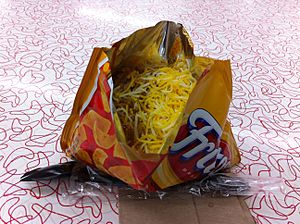
- Frito pie: A casserole with red chile sauce (sometimes with meat or beans) over Fritos corn chips. It's topped with cheese, and often shredded lettuce, chopped tomato, and onion.
- Some stores make it by opening a bag of Fritos and adding the other ingredients right into the bag. Even though it started in Texas, it's very popular in New Mexico and uses New Mexican red chile.
- Green chile cheeseburger: A regular hamburger topped with melted cheese and green chile. It has a very distinct New Mexican flavor. Even big fast-food chains offer it in New Mexico.
- Green chile cheese fries: French fries covered with green chile sauce and topped with cheese.
- Green chile stew: A stew with green chile, ground or cubed beef or pork, potato, diced tomato, onion, garlic, and chicken or beef broth.
- Guacamole: The traditional New Mexico version is mashed or blended avocados with small amounts of chopped onion, tomato, garlic, salt, and lemon juice.
- Huevos rancheros: Fried eggs on corn tortillas, covered with red or green chile sauce and shredded cheddar cheese. Often served with potatoes and/or pinto beans.
- Indian Fry Bread: A thick, deep-fried flatbread. It was developed by the Navajo people. It's served as a snack with honey or used to make Navajo tacos. The New Mexico sopaipilla is a type of fry bread.
- Jalapeño: A small, spicy chile pepper. In New Mexican food, they are chopped fresh in salsa and guacamole, or used as a topping (pickled or fresh) for nachos.
- Natillas: A soft, custard-like dessert made from egg whites, milk, sugar, vanilla, nutmeg, and cinnamon. It's cooked on a stove and served warm or cold.
- Navajo taco: A taco made with frybread instead of a tortilla.
- Pico de gallo: A cold salsa with thick-chopped fresh chiles, tomatoes, onions, and cilantro. It doesn't have a tomato-paste base or vinegar.
- Posole: A thick stew made with hominy and pork. Chicken is also a popular choice. It's simmered for hours with red or green chile, onion, garlic, and oregano. For New Mexicans, posole is a very important Christmas tradition.
- Quesadilla: Like a grilled cheese sandwich, but with two flour tortillas instead of bread. It's often lightly oiled and toasted to melt the cheese. Served with salsa, pico de gallo, chile, guacamole, or sour cream.
- Sopaipilla (or sopapilla): A puffed, fried quick bread. The New Mexico version is very large. It's served as a standard bread at New Mexican restaurants with honey or honey butter. They can also be stuffed with savory fillings like ground beef, chicken, or beans to make a meal.
- Stuffed sopapilla: A common New Mexico meal, filled with various ingredients, covered with melted cheddar cheese, usually smothered with red or green chile sauce, and topped with shredded lettuce and diced tomatoes.
- Spanish rice: Rice with a tomato base and other ingredients. It's usually mild. Traditional New Mexico versions use long-grain rice, onion, and garlic.
- Salsa: An uncooked mix of chiles/peppers, tomatoes, and onions. Often blended or mixed with tomato paste to make it more like a sauce. It usually has lemon juice or vinegar.
- The green-chile version is mostly green chile and usually no tomatoes. The New Mexico and California styles often have a lot of cilantro. The word "salsa" just means "sauce" in Spanish.
- Taco: A corn tortilla fried into a U-shape. It's filled with meats or beans, fresh chopped lettuce, onions, tomatoes, and cheese.
- The whole taco shell is fried, not the entire taco.
- Tamal (plural tamales): Meat rolled in cornmeal dough (masa), wrapped in corn husks, and steamed. The standard New Mexico tamal filling is shredded pork cooked in red chile sauce. New Mexican tamales often have red chile powder mixed into the masa.
- Tortilla: A flatbread made mostly from white wheat flour or cornmeal. Wheat flour tortillas are most common for everyday use. Blue-corn tortillas are also a classic New Mexico style.
- Tostada: A corn tortilla that is deep-fried flat until crispy. It's covered with refried beans, cheese, lettuce, and tomato. Extra toppings like sour cream and guacamole are often added.
Images for kids
-
A smothered, Christmas-style breakfast burrito from Tia Sophia's diner in Santa Fe, New Mexico



